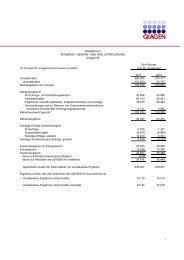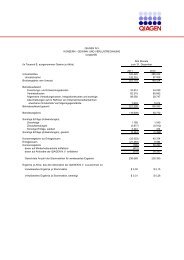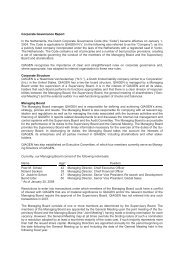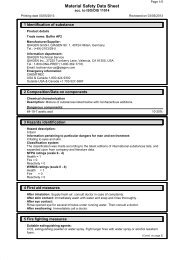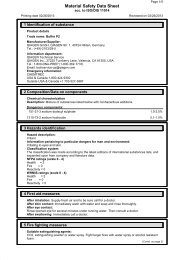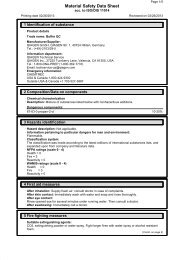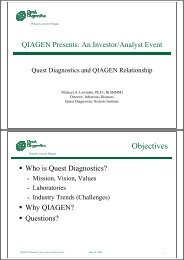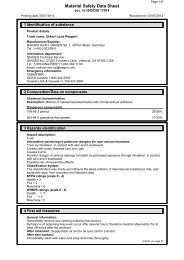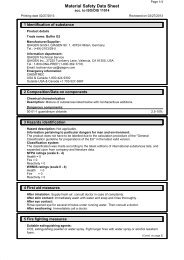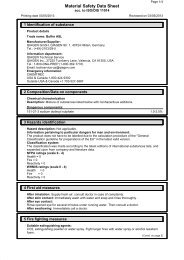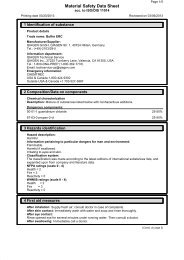QIAGEN N.V. Annual Report 2001
QIAGEN N.V. Annual Report 2001
QIAGEN N.V. Annual Report 2001
You also want an ePaper? Increase the reach of your titles
YUMPU automatically turns print PDFs into web optimized ePapers that Google loves.
$360,000, based on the year-end interest rate, a loan balance consistent with that at year-end and a constant foreign<br />
exchange rate. In February 2002, loan agreements related to EUR 50.0 million of the facilities was amended to be<br />
U.S. dollar denominated and the amount was fixed at $43.5 million at an interest rate of LIBOR plus 1.28%.<br />
Currency Fluctuations. The Company operates on an international basis. A significant portion of its revenues and expenses<br />
are earned and incurred in currencies other than the U.S. dollar. The euro is the most significant such currency, with<br />
others including the British pound, Japanese yen, Swiss franc, and Canadian and Australian dollars. Fluctuations in<br />
the value of the currencies in which the Company conducts its business relative to the U.S. dollar have caused and<br />
will continue to cause U.S. dollar translations of such currencies to vary from one period to another. Due to the number<br />
of currencies involved, the constantly changing currency exposures, and the potential substantial volatility of currency<br />
exchange rates, the Company cannot predict the effect of exchange rate fluctuations upon future operating results.<br />
However, because the Company has substantial expenses as well as revenues in each of its principal functional<br />
currencies, the exposure of its financial results to currency fluctuations is reduced. The Company seeks to mitigate<br />
what it believes to be a significant portion of the remaining risk through hedging transactions. In general terms,<br />
appreciation of the U.S. dollar against the Company’s other foreign currencies, such as occurred in 2000 and <strong>2001</strong><br />
with respect to the euro, will decrease reported net sales. However, this impact normally will be at least partially<br />
offset in the results of operations by gains or losses from foreign currency transactions.<br />
27<br />
Currency Hedging. In the ordinary course of business, the Company purchases foreign currency exchange options to<br />
manage potential losses from foreign currency exposures. These options give the Company the right, but not the<br />
obligation, to sell foreign currencies in exchange for U.S. dollars at predetermined exchange rates. The principle<br />
objective of such options is to minimize the risks and/or costs associated with global financial and operating<br />
activities. The Company does not utilize financial instruments for trading or other speculative purposes. At December 31,<br />
<strong>2001</strong>, the notional amount of foreign currency exchange options was $6.8 million. The functional currency of<br />
$5.6 million of the foreign currency exchange options was the euro, with a notional weighted average exchange rate<br />
of 1.0000. The functional currency of the remaining $1.2 million foreign currency exchange options was the<br />
Swiss franc, with a notional weighted average exchange rate of 1.5500.<br />
Foreign Currency Exchange Rate Risk. The Company’s principal production and manufacturing facility is located in<br />
Germany and intercompany sales of inventory expose the Company to foreign currency exchange rate risk. Intercompany<br />
sales of inventory are generally denominated in the local currency of the subsidiary purchasing the inventory in order<br />
to centralize foreign currency risk with the Company’s German subsidiary. Payment for intercompany purchases of<br />
inventory is required within 30 days from invoice date. The delay between the date the German subsidiary records<br />
revenue and the date when the payment is received from the purchasing subsidiaries exposes the Company to<br />
foreign exchange risk. The exposure results primarily from those transactions between Germany and the U.S.<br />
At year-end, the Company’s long-term debt with Deutsche Bank was denominated in euros. Approximately $44.5 million<br />
was loaned to <strong>QIAGEN</strong> Sciences, Inc., therefore, the Company internally bears currency exchange rate risk and<br />
changes in the foreign exchange rate will affect earnings. In February 2002, the terms of the loan agreements were<br />
amended so that the portion of the loan payable from U.S. subsidiaries is denominated in U.S. dollars.<br />
The foreign currency exchange rate risk is partially offset by transactions of the German subsidiary denominated in<br />
U.S. dollars. Hedging instruments include foreign currency put options that are purchased to protect the existing and/or<br />
anticipated receivables resulting from intercompany sales from Germany to the U.S. These options give the Company<br />
the right, but not the obligation, to sell foreign currencies in exchange for U.S. dollars at predetermined exchange<br />
rates. Management does not believe that the Company’s exposure to foreign currency exchange rate risk is material.



